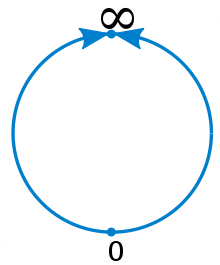Gluing schemes
In algebraic geometry, a new scheme (e.g. an algebraic variety) can be obtained by gluing existing schemes through gluing maps.
Statement
Suppose there is a (possibly infinite) family of schemes and for pairs , there are open subsets and isomorphisms . Now, if the isomorphisms are compatible in the sense: for each ,
- ,
- ,
- on ,
then there exists a scheme X, together with the morphisms such that[1]
- is an isomorphism onto an open subset of X,
- on .
Examples
Projective line

Let be two copies of the affine line over a field k. Let be the complement of the origin and defined similarly. Let Z denote the scheme obtained by gluing along the isomorphism given by ; we identify with the open subsets of Z.[2] Now, the affine rings are both polynomial rings in one variable in such a way
- and
where the two rings are viewed as subrings of the function field . But this means that ; because, by definition, is covered by the two open affine charts whose affine rings are of the above form.
Affine line with doubled origin
Let be as in the above example. But this time let denote the scheme obtained by gluing along the isomorphism given by .[3] So, geometrically, is obtained by identifying two parallel lines except the origin; i.e., it is an affine line with the doubled origin. (It can be shown that Z is not a separated scheme.) In contrast, if two lines are glued so that origin on the one line corresponds to the (illusionary) point at infinity for the other line; i.e, use the isomrophism , then the resulting scheme is, at least visually, the projective line .
Fiber products and pushouts of schemes
The category of schemes admits both a finite fiber product and a finite pushout;[4] they both are constructed by gluing affine schemes. For affine schemes, fiber products and pushouts correspond to tensor products and fiber squares of algebras.
References
- Hartshorne, Ch. II, Exercise 2.12.
- Vakil, § 4.4.6.
- Vakil, § 4.4.5.
- https://stacks.math.columbia.edu/tag/07RS
- Hartshorne, Robin (1977), Algebraic Geometry, Graduate Texts in Mathematics, 52, New York: Springer-Verlag, ISBN 978-0-387-90244-9, MR 0463157
- Vakil, Math 216: Foundations of algebraic geometry Nov 2017 version.